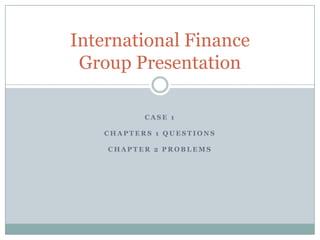International Finance
•Download as PPTX, PDF•
1 like•2,423 views
Answer to some questions from my textbook while on exchange. Simple math, good times !
Report
Share
Report
Share

Recommended
Recommended
More Related Content
Similar to International Finance
Similar to International Finance (20)
Chapter 5 How Managers Use Balance of Payments Data – p.213Do.docx

Chapter 5 How Managers Use Balance of Payments Data – p.213Do.docx
Mkt 100 021 - week 1 - intro and principles of marketing new

Mkt 100 021 - week 1 - intro and principles of marketing new
HSA 550 – Homework 1Due Week 2 and worth 34 pointsDirect.docx

HSA 550 – Homework 1Due Week 2 and worth 34 pointsDirect.docx
Business Economics 02 Introduction to Business Economics

Business Economics 02 Introduction to Business Economics
International Finance
- 1. Case 1 Chapters 1 Questions Chapter 2 Problems International FinanceGroup Presentation
- 2. Case 1: The Debate Over Outsourcing 1. What are the pros and cons of outsourcing?
- 3. Case 1: The Debate Over Outsourcing 2. How does outsourcing affect US producers and consumers? Consumers: Cheaper goods and services Language Barrier/Communication Quality discrepancies (inconsistency)
- 4. Case 1: The Debate Over Outsourcing 2. (cont.) Producers: Lowers cost Focus on your core competencies Improve productivity Improves competitiveness (cheaper product cost) Innovation/Technology Loss of control
- 6. Investing in continuing education will lead to a more educated and capable workforce in key strategic industries
- 7. Improves the standard of living
- 9. Inefficient allocation of taxpayer funds
- 10. Jobs “saved” – short run
- 12. Question 3,4 Chapter 1 :Introduction – The Multinational Enterprise and Financial Management
- 13. Chapter 1 Questions 3. Elaborate on the benefits of a proactive approach to globalization and global competition. Predict the future consumer taste. More choices/variety for customers First mover advantage Economies of scale; increased productivity Efficient allocation of resources Countries can predict employment trends.
- 14. Chapter 1 Questions “ Companies today operate within a global market place and can ignore this fact only at their peril” - Jack Welch i.e. Survival of the Fittest
- 15. Chapter 1 Questions 4. What are the various reasons for the emergence of multinational firms? Market seeking- (new markets/gain market share) Cost minimization- (economies of scale, cheap labor) Knowledge seeking – (new technology/processes) Keeping domestic customers – (follow customers) Exploiting financial market imperfections Diversification Closer to raw materials
- 16. Problem 2, 3 Chapter 2 : The Determination of Exchange Rates
- 17. Chapter 2 Problems 2. In 2002, one dollar bought ¥125. In 2006 it bought about ¥115. What was the dollar value of the yen in 2002? 1 ¥ = $0.008 (or 0.8 ¢) US What was the yen’s dollar value in 2006? 1 ¥ = $0.008696 (or 0.87 ¢) US
- 18. Chapter 2 Problems b) By what percent has the yen risen in value between 2002 and 2006? 8.7% increase in value c) By what percent has the dollar fallen in value between 2002 and 2006? 8% decrease in value
- 19. Chapter 2 Problems 3. On February 1, the euro is worth 1.2966. By May 1st it has moved to $1.3634. By what percent has the euro appreciated or depreciated against the dollar during this period? 5.15 % appreciation in the value of the euro By what percent has the dollar appreciated or depreciated against the euro during this period? 4.9% depreciation in the value of the dollar
- 20. Questions -or- Comments Thank You